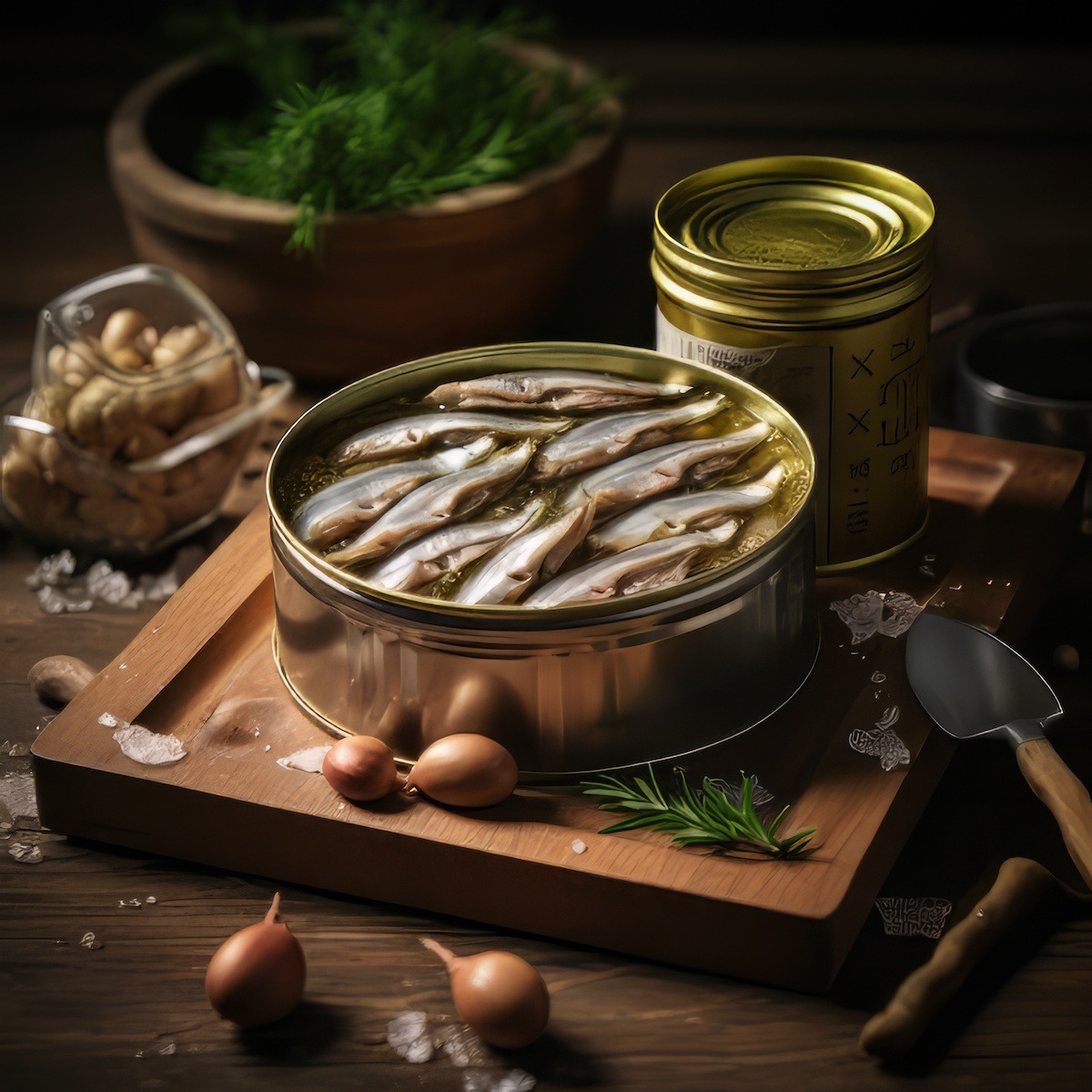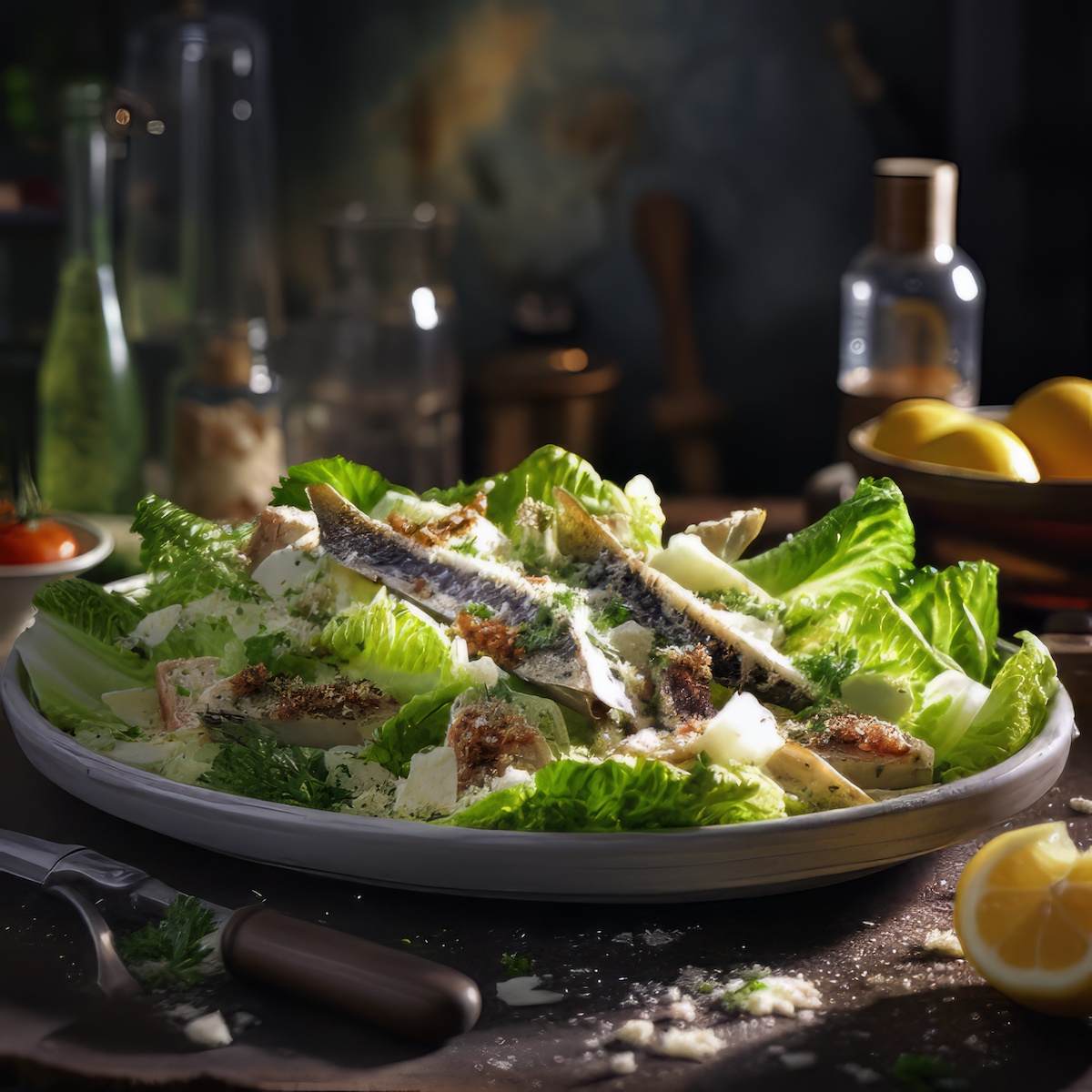

Tin of Anchovies
What Are Anchovies?
Anchovies, small, silvery fish that pack a punch of flavor, have a storied history in the culinary world. These tiny, oily fish belong to the Engraulidae family and are found in temperate waters around the globe. Despite their diminutive size, anchovies have left an indelible mark on various cuisines, adding a distinctive and intense taste to a wide array of dishes.
What Do Anchovies Taste Like?
Anchovies are renowned for their distinctive and intense flavor. The taste of anchovies is characterized by a combination of saltiness, umami, and a slightly fishy and briny profile.
The saltiness comes from the curing process, during which anchovies are typically preserved in salt. This process not only helps in preservation but also enhances the overall flavor, giving anchovies their characteristic salty kick.
The umami taste, often described as savory and full-bodied, is a significant component of anchovy flavor. This umami quality is attributed to compounds like glutamate, which are concentrated during the curing process. Umami is a key element in many savory dishes, and anchovies contribute a rich and complex layer of this taste.
Some people also detect a mild fishiness in anchovies, which is natural given their marine origin. However, the strong curing process helps mellow out the fishiness to a certain extent, leaving behind a more nuanced and balanced flavor. The brininess, reminiscent of the sea, further adds to the overall taste profile.
Use in Small Quantities
It’s important to note that anchovies are often used in small quantities in recipes due to their potent flavor. While some may find the taste of anchovies quite assertive, others appreciate the depth and complexity they bring to dishes. Anchovies are frequently used as a seasoning or ingredient in various dishes, contributing their unique taste to sauces, dressings, pizzas, salads, and more.
Additionally, the way anchovies are prepared and incorporated into a dish can influence their flavor impact. Anchovy fillets, anchovy paste, or anchovy-infused oils are common forms in which anchovies are used, each offering a slightly different intensity and texture to the final culinary creation.
Anchovies have a bold and memorable taste characterized by saltiness, umami richness, a hint of fishiness, and a touch of brininess. Whether loved for their distinctive flavor or approached with caution, anchovies continue to be a versatile ingredient that adds depth and complexity to a wide range of culinary delights.
Anchovy Paste
One of the most common uses of anchovies is in the form of anchovy fillets or anchovy paste. These products are often employed to enhance the umami flavor in dishes ranging from salads and pizzas to pasta sauces.
The intense and salty taste of anchovies allows them to function as a robust seasoning, elevating the overall taste profile of a dish. Even a small quantity of anchovies can transform a mundane recipe into a culinary delight.
Anchovies are culinary powerhouses that have stood the test of time. From their ancient roots in Mediterranean kitchens to their essential role in Asian cuisines, these tiny fish continue to make a big impact on global gastronomy. Whether as a key player in a classic Caesar salad or as the secret ingredient in a umami-packed broth, anchovies demonstrate that size is no barrier to flavor, and their presence in the culinary world is sure to endure for generations to come.
History
Originating from the Mediterranean region, anchovies have been a culinary staple for centuries. The ancient Romans and Greeks used them liberally in their cooking, recognizing the depth of flavor they could contribute.
Over time, anchovies became a vital ingredient in various traditional Mediterranean dishes, such as the famous Caesar salad, where the salty kick of anchovies complements the freshness of lettuce and the richness of the dressing.
In addition to their historical significance in Mediterranean cuisine, anchovies play a prominent role in Asian culinary traditions. In countries like Japan and Korea, anchovies are often used to make dashi, a foundational broth in many Japanese dishes.
The umami-packed broth derived from anchovies adds a unique depth to soups, stews, and sauces. Similarly, in Korean cuisine, anchovies are a key component in making kimchi, a staple fermented vegetable dish.
Processing
The process of preserving anchovies is as fascinating as their culinary applications. Typically, anchovies are cured in salt for several months, which not only preserves them but also intensifies their flavor.
The curing process dates back centuries and was a crucial method for preserving fish in the absence of modern refrigeration. Today, this traditional preservation technique endures, contributing to the distinctive taste that makes anchovies a sought-after ingredient.

Anchovies Swimming in the Sea
Nutritional Value
Beyond their culinary uses, anchovies have nutritional value that often goes overlooked. Packed with omega-3 fatty acids, essential for heart health, and rich in protein, anchovies offer a nutrient-dense option for those looking to boost their dietary intake of these vital elements.
While anchovies may be an acquired taste for some due to their potent flavor, the health benefits they offer add another layer of appeal to these small, silver fish.
Characteristics
Size and Appearance: Anchovies are small fish, typically measuring about 2 to 4 inches in length. They have a slender, silvery body with a dark blue-green hue on the upper side.
Flavor: Anchovies have a strong, savory, and salty flavor. The taste is intensified due to the curing and fermentation processes used in their preparation.
Culinary Uses: Anchovies are often used as a flavoring agent in dishes rather than being consumed on their own. They are commonly used in Mediterranean cuisine to add depth to pasta sauces, salads, dressings, and spreads. In Asian cuisines, anchovies may be used in sauces, stir-fries, and soups.
Processing Methods: Anchovies are processed in various ways to make them suitable for culinary use. Common methods include curing them in salt, packing them in oil, or fermenting them. The curing process develops the characteristic umami-rich flavor.
Anchovy Paste: Anchovy paste is a common form in which anchovies are used in cooking. The paste is made by grinding anchovies into a smooth consistency, making it easy to incorporate into recipes. Anchovy paste is often used to enhance the flavor of dressings, sauces, and marinades.
Storage: Anchovies are often sold in jars or cans, either packed in salt or oil. Properly sealed and stored, anchovies have a long shelf life.
Umami: Anchovies are known for their umami, the fifth basic taste alongside sweet, sour, salty, and bitter. Umami is often described as a savory or meaty taste, and anchovies contribute this rich flavor to dishes.
Substitutions: If anchovies are not available or if someone prefers to avoid them, alternatives like anchovy paste, fish sauce, or soy sauce can be used to add umami to recipes.
Nutritional Content: Anchovies are a good source of protein, omega-3 fatty acids, and various vitamins and minerals. However, due to their intense flavor, they are often used sparingly in dishes.

Anchovies in a Caesar Salad
Buying and Storing
- Buying and storing anchovies properly is crucial to preserving their flavor and ensuring their quality. Here are some tips for the best way to buy and store anchovies:
- Freshness Matters: If you have access to fresh anchovies, choose ones with clear eyes, shiny skin, and a fresh, ocean-like smell. However, fresh anchovies are not as common as the cured or canned varieties.
- Canned or Jarred Anchovies: Most commonly, anchovies are available in cans or glass jars. When purchasing these, check the expiration date and inspect the packaging for any signs of damage or bulging.
- Quality Brands: Opt for reputable brands known for producing high-quality anchovies. Look for products that use good-quality fish and follow traditional curing methods.
Storing Anchovies:
- Refrigeration is Key: Once opened, store in the refrigerator. The cool temperature helps slow down deterioration. Unopened cans or jars can be stored in a cool, dark pantry or cupboard.
- Transfer to an Airtight Container: If they come in a can, consider transferring any leftovers to an airtight container after opening. This can help maintain freshness and prevent the fishy odor from spreading to other items in the refrigerator.
- Cover with Oil: If you buy them packed in oil, make sure the fish are fully submerged. The oil helps preserve the anchovies and prevents them from drying out.
- Use Quickly after Opening: While anchovies have a relatively long shelf life, it’s best to use them within a few weeks after opening. The longer they are exposed to air, the more their quality may degrade.
- Frozen Anchovies: If you have access to fresh anchovies or larger quantities, consider freezing them. Clean, gut, and store them in an airtight bag. Freezing helps maintain their freshness for a longer period.
- Avoid Cross-Contamination: To prevent cross-contamination in the refrigerator, store anchovies away from other foods. Their strong flavor can easily be absorbed by nearby items.
- Check for Spoilage: Before using anchovies, especially if they have been stored for a while, check for any signs of spoilage, such as off smells, discoloration, or mold. Discard any anchovies that show these signs.
By following these guidelines, you can ensure that your anchovies remain flavorful and ready to enhance your culinary creations. Whether you’re using them as a pizza topping, salad ingredient, or flavor booster in sauces, properly stored anchovies will contribute their unique taste to your dishes.nchovies?
They can be a polarizing ingredient – some people love their bold flavor, while others find it too strong. Their versatility makes them a staple in many kitchens, adding depth and complexity to a wide range of savory dishes.
Some of My Favorite Ingredients
 Print
Print




